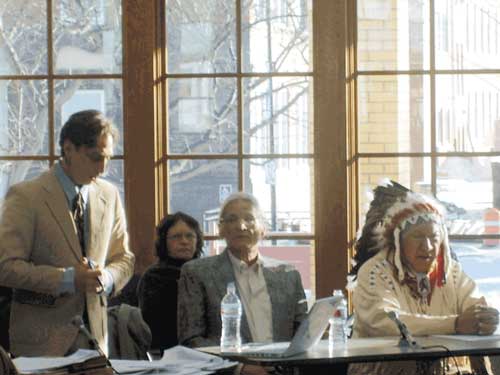Posted: May 09, 2008 by: Rob Capriccioso
 |
||
| Photo courtesy Debra White Plume -- Oglala Sioux Tribe Chief Joe American Horse testified before a panel of Nuclear Regulatory Commission judges in January. |
WASHINGTON - The U.S. Nuclear Regulatory Commission has given hope to a growing group of Natives from the Pine Ridge Indian Reservation in what's being called a classic ''David vs. Goliath'' battle for federal oversight involving a proposed expansion of a nearby uranium mine.
A three-judge panel from the commission ruled in late April that Native opponents to new developments on the Crow Butte Resources mine, located approximately 30 miles south of the reservation, raised valid arguments regarding groundwater contamination and health issues. The panel called for oral arguments on the matter, as well as a hearing on objections to the foreign ownership of the mine, which is owned by the Canadian firm Cameco Corp., the world's largest uranium producer.
NRC's whopping 130-page decision came as a result of Cameco's desire to expand the mine, which opened in 1991 and produces approximately 800,000 pounds of yellowcake uranium each year. Crowe Butte officials have been petitioning to renew their existing license, and have filed notices of intention to develop two new uranium mines.
For several years, members of the Oglala Sioux Tribe have monitored developments at the 2,100-acre Crow Butte site. Many have growing concerns that activities there are affecting the quality of water on their lands, perhaps even leading to higher cancer rates and increased health problems for children and elders.
''The Nuclear Regulatory Commission has basically given us the right to fight for our rights,'' said Debra White Plume, director of Owe Aku/Bring Back the Way, a nonprofit Lakota cultural group on Pine Ridge. She notes that raising funds to challenge Cameco has been difficult; lawyers have been working largely pro bono on behalf of opponents, but science experts have been costly to retain.
NRC named Owe Aku and the Western Nebraska Resources Council, an environmental advocacy group, as parties in the forthcoming hearings. Tribal leaders, including Chief Oliver Red Cloud and Chief Joe American Horse, have also made arguments against the proposed expansion, and the OST could eventually become a plaintiff in the case. Well-known Indian leaders, including Winona LaDuke, are supporting the efforts as well.
Some opponents to the expansion believe that fractures in underground rock allow the water used in Cameco's mining process ultimately to end up mixing with water that people use for drinking and sanitation, thereby spreading contamination from one aquifer to others.
Miners remove uranium by pumping water and bicarbonate into the ground; they then withdraw the solution and recover the mineral. Preliminary scientific evidence suggests water near Pine Ridge contains contaminants associated with underground minerals and metals being disturbed, and more research is under way.
''It's a desecration of Mother Earth,'' White Plume said. ''In the Lakota way of thought, water is sacred - it's our first tool, our first dwelling, our first medicine. It's a gift. Water is our relation, and it's our obligation to protect our relation.''
White Plume's argument might have legal footing under the ''Winters Doctrine,'' which serves to preserve Indian water rights. The OST also recently passed an ordinance declaring its land a nuclear-free zone, and leaders have promised to prosecute violators.
''Once you contaminate that groundwater, you cannot recapture that contamination,'' White Plume said. ''And we're going to live here - our future generations are going to live here - and we are going to suffer the impacts of that contamination.''
Cameco officials insist their leach mining process is safe, noting that 100 to 200 feet of impermeable underground material separates aquifers near the Crow Butte mine from aquifers that are used to give water to people. They also say they closely monitor wells to detect and fix any problems.
Regarding the NRC ruling to further examine the expansion, Gord Struthers, a spokesman for Cameco, said the uranium company respects the regulatory process.
''We're committed to safe and sustainable operations,'' he said. ''And we're following the process in good faith.''
Struthers added that Cameco ''would never propose anything that wasn't entirely safe and protective of people's health.'' After more scientific review, he expects there will be no question that the proposed expansion is safe.
But lawyers for the opponents to the expansion think Cameco has not being entirely forthcoming, and believe further NRC review will have dramatic consequences for the company.
David Frankel, a lawyer representing the Western Nebraska Resources Council, said that there is no authority under federal law for a foreign-owned company, such as Cameco, to receive licenses to mine uranium in the U.S.
''It amounts to the illegal exportation of nuclear materials,'' he said, and added that under the Atomic Energy Act, the government is authorized to regulate the transfer of nuclear materials under ''U.S. national interests.''
''It looks like our country's resources, especially those in Indian country, are being picked off by foreign companies so that uranium can be sold on the market to the highest bidder,'' Frankel said. ''That's not so good for the U.S. because it does pollute our water, it does pollute our environment.''
If the Crow Butte mine is harming American Indians and others, it would be a violation of the law, according to Frankel.
''This is an abusive situation. When people are wondering if they can safely go into sweat lodges, something is wrong.''
NRC officials said a decision on whether to permit the Crowe Butte mine expansion is still several months away.
© 1998 - 2008 Indian Country Today. All Rights Reserved To subscribe or visit go to: http://www.indiancountry.com